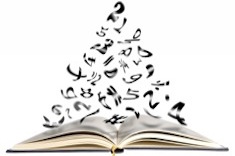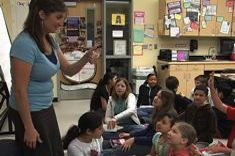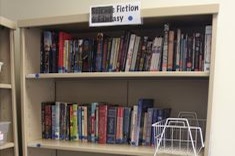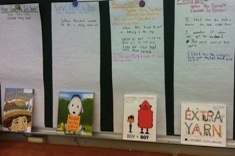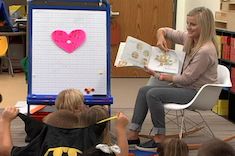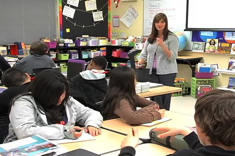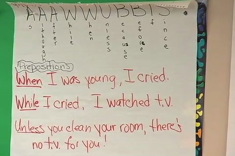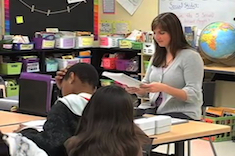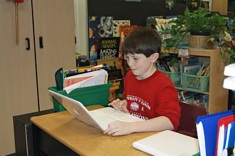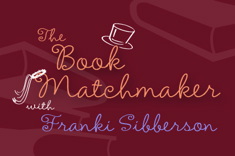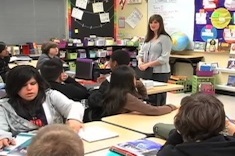7th
Latest Content
Literacy Contracts: Introduction
Megan Ginther and Holly Mueller present Reading Contracts, a system for middle and high school teachers that involves students contracting to complete specific texts and tasks each month.
Using Pinterest for Professional Development
Franki Sibberson finds Pinterest is a useful tool for professional development.
Helping Students Evaluate Online Video for Research
Even if your district is blocking web video now, it's not going anywhere. As time goes on, schools will rely more and more on video available from the Internet for research and learning. Bill Bass has practical advice for helping middle and high school students assess everything from suspect sources to appalling comments on the Wild Wild Web.
First Read Alouds (ROUND-UP)
Choice Literacy contributors share their picks for the first read aloud of the year.
A Summer Reading Camp for Middle School Students
Katherine Sokolowski has tips for a "book club" summer reading camp for middle school students.
Independent Reading By the Numbers Is NOT Text Complexity
How do you guide students to select books for independent summer reading? Aimee Buckner challenges teachers who are requiring middle students to pick books based solely on Lexile scores.
Death in Books: Finding Our Way After Loss
Books can help children deal with the toughest challenges in life. In a new booklist, Andie Cunningham shares her top picks for stories about characters grappling with the death of a loved one.
Understanding the Middle East Through Children’s Literature (BOOKLIST)
Sheiks, harems, and terrorists — the stereotypes of the middle east from popular culture may not be realistic, but they sure are pervasive. Ruth Shagoury and Andie Cunningham find authentic alternative views to present to children in their new booklist.
The Truth About Building a Writing Community in Middle School
Building a sense of community is complicated in middle school classrooms. Katie Baydo-Reed considers her eighth graders, and is surprised at what endures most with these young teens.
Student-Selected Vocabulary in Middle School
Katie Doherty shares many ways to make vocabulary learning fun in middle school, beginning with students working together to select words to study each week.
Curating the Classroom and School Library
As classroom budgets get tighter, teachers rely more and more on school libraries for books. Erin Ocon describes how she has changed the way she matches books and readers in her middle school classroom, depending more on school library resources and helping her middle school students navigate them.
Eyes on the Fries: Just-Right Books and Reading Peer Pressure in Middle School
Gretchen Taylor addresses the issue of "peer-pressured reading" in middle school reading workshops, with a practical example of how she helped her students move beyond the fad book of the moment to more thoughtful previewing and independent reading choices.
Book Matchmaker: Fairy Tales for Older Readers
Renew older students' interest in fantasy and fairy tales with these suggestions of recent titles from Franki Sibberson.
Value-Added: Moving Assessments from “Inflicted” to “Student-Owned”
Gretchen Taylor looks closely at the superficial reading responses of one student, and then uses a mid-year assessment to challenge all of her middle school readers to think, talk, and write more deeply about their reading.
Creating Anchor Charts with Multiple Classes
It’s a dilemma many middle school teachers face. How do you construct anchor charts with multiple groups of students, when only one chart will be hung in the room? Katherine Sokolowski explains how she ensures all classes have input and a “clean slate” in constructing charts.
The Apple Doesn’t Fall from the Tree: Nurturing Critical Thinking and Choice with Middle School Writers
Katie Baydo-Reed has to try, try, and try again to get high quality writing and thinking from her eighth graders, but the effort builds independence and reflection.
Opening Doors to Parents in Middle School
Gretchen Taylor finds middle school parents enjoy hearing about their child’s day — it’s just a matter of getting creative in dealing with the large number of families.
Helping Middle School Readers Set Goals
In the final installment of a two-part series, Gretchen Taylor explains how to help middle school readers set goals.
Field Experience: Social-Emotional Learning in Workshop
Compassion and understanding are as important to workshop instruction as strategies and routines. Ruth Ayres compiled a field experience to highlight the way understanding the social-emotional needs of students (and ourselves) allows for safe learning environments.
Field Experience: Picture Books and Older Students
The value of picture books with older students is often questioned. Ruth Ayres assembled this field experience to allow insight into the depth and power of picture books for older students.
Running and Middle School Reading Goals
Gretchen Taylor helps her middle school students analyze their needs as readers and set benchmarks for growth.
Worldwide Cinderellas
Erin Ocon discovers that worldwide Cinderella stories are a wonderful tool for building community and cultural awareness in her seventh-grade classroom and with English language learners. Erin describes how she uses a range of Cinderella picture books with students, and provides an extensive booklist for expanding your library.
Quick Take: Using Timers in Middle School Writing Workshops
In this video quick take, Katie Doherty explains why she finds a timer helpful in her middle school writing workshop.
Getting Started with Sentence Observations
Karen Terlecky details the assessments and preparation that goes into the design of her sentence observation program.
From “I Don’t Get It” to “Never Mind — That’s Amazing!”: Scaffolding Schema for Comprehending Poetry
Katie Doherty finds poetry is a powerful tool for helping her middle school students understand the value of schema while reading.
The Affect of Tech on Splrs
Heather Rader considers the cultural divide between teachers and students who are “screenagers” when it comes to texting. If u r getting LOLed out in ur classroom u might want 2 read this.
Book Matchmaker: 5th Grade English Language Learners
Robin Heist is an elementary teacher looking for books for her older English language learners who are reading below grade-level expectations.
Why Read? – A Question to End the School Year
“Why read?” This is the question asked every spring in Erin Ocon’s middle school classroom, and in the process of answering it, she and her students rediscover a lot of what they’ve learned together throughout the year.
Lifting the Quality of Student Reading Letters with Quotes
Katie Doherty demonstrates for her middle school students how quotes can lift the quality of writing, using student and literary examples in this 11-minute video.
Learning to Write Engaging Nonfiction: A Middle School Partner Writing Study
Ann Marie Corgill takes a big risk and pairs her middle-school students randomly for a nonfiction writing project, and finds the risk pays off.
Browse Content By
Type
Category
- Assessment Tools
- Big Fresh Archives
- Booklists
- Choice Numeracy
- Classroom Design
- Common Core
- Community Building
- Conferring
- Content Literacy
- Digital Literacy
- English Language Learners
- Equity
- Family Relations
- Free Samples
- Guiding Groups
- Leadership
- Literacy Coaches
- Mentor Texts
- Minilessons
- New Teacher Mentors
- Podcasts
- Poetry
- Quote Collections
- Reading Strategies
- Self Care
- Struggling and Striving Learners
- Talking and Listening
- Teacher Study Groups
- Teaching Reading
- Teaching Writing
- Word Study and Vocabulary
Author
- Melissa Quimby
- Nawal Qarooni
- Gwen Blumberg
- Julie Cox
- The Lead Learners
- Hannah Tills
- Josie Stewart
- Ruth Metcalfe
- Mallory Messenger
- Becca Burk
- Jodie Bailey
- Vivian Chen
- Mary Brower
- Tiffany Abbott Fuller
- Stephanie Affinito
- Ruth Ayres
- Leigh Anne Eck
- Heather Fisher
- Shari Frost
- Julie Johnson
- Suzy Kaback
- Gigi McAllister
- Shirl McPhillips
- Melanie Meehan
- Cathy Mere
- Debbie Miller
- Tara Barnett and Kate Mills
- Tammy Mulligan
- Dana Murphy
- Bitsy Parks
- David Pittman
- Brenda Power
- Heather Rader
- Matt Renwick
- Mandy Robek
- Christy Rush-Levine
- Gretchen Schroeder
- Jen Schwanke
- Brian Sepe
- Katherine Sokolowski
- Stella Villalba
- Jennifer Vincent
Grade Level
Choice Literacy Membership
Articles
Get full access to all Choice Literacy article content
Videos
Get full access to all Choice Literacy video content
Courses
Access Choice Literacy course curriculum and training






